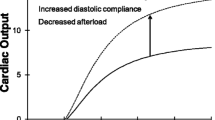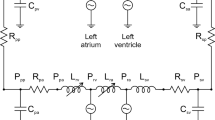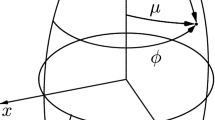Abstract
The third heart sound (S3) is observed for various hemodynamic conditions in both the normal and diseased heart. A theory is proposed in which myocardial viscoelasticity is primarily responsible for S3. A mathematical model is developed based on the mechanical aspects of diastolic function: nonlinear elasticity, viscoelasticity, and pressure generation. The model is provided as an electrical analogy of the left ventricle and circulatory system. S3 is predicted for the normal heart and the heart with dilated cardiomyopathy. An elevation of S3 intensity is indicated for cardiomyopathy, as is often observed in the clinic. S3 is produced experimentally by volume loading of the open-chest canine preparation and mathematically by imposing the conditions of volume loading on the model. Consistency of theory and experiment imply that it is valid to attribute S3 to myocardial viscoelasticity. The animal whose heart possessed the largest constant of viscoelasticity produced the greatest level of S3, in both cases. Nonlinear ventricular compliance is not found to be an essential requirement for sound generation, although increased compliance led to an increase in sound. S3 is predicted to change in response to venous return, ventricular stiffness, contractility, heart rate, and duration of contraction, as observed by others. In general, the coupling of these quantities to S3 is explained in terms of an excitation of viscous properties of the ventricle.
Similar content being viewed by others
References
Dock, W.; Grandell, F.; Taubman, F. The physiologic third heart sound: Its mechanism and relation to protodiastolic gallop. Amer. Heart J. 50:449–464; 1955.
Drzewiecki, G.; Krawciw, N. An electronic implementation of left heart pumping. Med. Electronics. 19:118–122; 1988.
Drzewiecki, G.M.; Wasicko, M.; Li, J.K-J. Diastolic cardiac properties and the origin of the third heart sound. Proc. 7th Int. Conf. Cardiovascular System Dynamics Society, Session 3, Zuoz, Switzerland. 1986: p. 4.
Drzewiecki, G.M.; Karam, E.; Welkowitz, W. Mechanisms leading to the development of isovolumic pressure during ventricular relaxation. Proc. 8th Ann. Conf. IEEE/EMBS, Boston, MA. 1987: pp. 525–526.
Drzewiecki, G.M.; Karam, E.; Wagner, T. Examination of the time-varying elastance model during ventricular relaxation. Proc. 8th Int. Conf. Cardiovasc. System Dynamics Society, Osaka, Japan. 1987: p. 181.
Drzewiecki, G.M.; Karam, E.; Welkowitz, W. Physiological basis for mechanical time variance in the heart: Special consideration of non-linear function. J. Theoretical Biology. 139:465–486; 1989.
Drzewiecki, G.M.; Melbin, J.; Noordergraaf, A. The Korotkoff sound. Ann. Biomedical Eng. 17: 325–359; 1989.
El Gamal, M.; Smith, D. Occurrence of a left ventricular third heart sound in incompetent mitral heterografts. British Heart J. 32:496–500; 1970.
Fleming, J. Evidence for a mitral valve origin of the left ventricular third heart sound. British Heart J. 31:192–199; 1969.
Gaasch, W.; Battle, W.; Obuler, J.; Levine, H. Left ventricular stress and compliance in man with special reference to normalized ventricular function curves. Circulation 45:746–768; 1972.
Grossman, S.; McLaurin, L.; Rolett, E. Alterations in left ventricular relaxation and diastolic compliance in congestive cardiomyopathy. Cardiovascular Research 13:514–522; 1979.
Laskey, W.; Shroff, S.; Kussmail, W.; Martin, J.; Kleaveland, P.; Hirshfield, J. Arterial pressure/flow relationships in heart failure due to congestive cardiomyopathy. Proc. Cardiovascular System Dynamics Society, Philadelphia, PA. 1984: pp. 324–327.
Meisner, J.S.; Yellin, E.L. Model of LV filling dynamics and diastolic function. Proc. 38th Ann. Conf. Eng. Med. Biol., Chicago, IL. 1985: p. 201.
Melbin, J.; Summerfield, S.; Noordergraaf, A. Nonlinear structural and material properties and models: The pulmonary trunk. Ann. Biomedical Eng. 16:175–200; 1988.
Mirsky, I.; Parmley, W.W. Assessment of passive elastic stiffness for isolated heart muscle and intact heart. Circ. Res. 33:233–243; 1973.
Nikolic, S.D.; Tamura, K.; Tamura, T.; Dahm, M.; Frater, R.W.M.; Yellin, E.L. Diastolic viscous properties of the intact canine left ventricle. Circulation Research. 67:352–359; 1990.
Noble, M.; Milne, E.; Goerke, R.; Carlsson, E.; Domenech, R.; Saunders, K.; Hoffman, J. Left ventricular filling and diastolic pressure-volume relations in the conscious dog. Circ. Res. 29:269–283; 1969.
Noordergraaf, A. Circulatory system dynamics. New York: Academic Press; 1978.
Ozawa, Y.; Smith, D.; Craige, E. Origin of the third heart sound: I. Studies in dogs. Circulation 67:393–398; 1983.
Rankin, J.; Arentzen, C.; McHale, P.; Ling, D.; Anderson, R. Viscoelastic preperties of the diastolic left ventricle in the conscious dog. Circ. Res. 41:37–45; 1977.
Rushmer, R. Cardiovascular dynamics. 4th ed. Philadelphia: W.B. Saunders; 1976.
Sakamoto, T.; Ischiyasu, H.; Hayashi, T.; Kawarantani, H.; Amano, K.; Yoshiyuki, H. Genesis of third heart sounds: Phonoechocardiographic studies. Japanese Heart J. 17:150–162; 1976.
Smith, J. Observations on the mechanism of the physiologic third heart sound. Amer. Heart J. 28:661–668; 1944.
Stefadouros, M.; Little, R. The cause and clinical significance of diastolic heart sounds. Arch. Internal Med. 140:537–541; 1980.
Stein, P.D. A physical and physiological basis for the interpretation of cardiac ausculation. New York: Futura; 1981.
Suga, H.; Sagawa, K. Instantaneous pressure-volume relationships and their ratio in the excised, supported canine left ventricle. Circ. Res. 35:117–126; 1974.
Sunagawa, K.; Yamada, A.; Senda, Y.; Kikuchi, Y.; Nakamura, M.; Shibahara, T.; Nose, Y. Estimation of the hydromotive source pressure from ejecting beats of the left ventricle. IEEE Trans. Biomed. Eng. 27:299–305; 1980.
Takagi, T.; Koiwa, Y.; Ohyama, T.; Kikuchi, J-I.; Honda, H.; Hoshi, N.; Takishima, T.; Tezuka, F. Sensitivity of the transfer function for intracellular edema during hypothermic open chest surgery. Proc. Circulatory System Dynamics Soc., Halifax. 1988; pp. 335–338.
Van de Werf, F.; Geboers, J.; Kesteloot, H.; Degeest, H.; Barrios, L.; The mechanism of disappearance of the physiological third heart sound with age. Circulation 73:877–884; 1986.
Van de Werf, F.; Boel, A.; Geboers, J.; Minten, J.; Willems, J.; Degeest, H.; Kesteloot, H. Diastolic properties of the left ventricle in normal adults and in patients with third heart sounds. Circulation 69:1070–1078; 1984.
Van de Werf, F.; Minten, J.; Carmeliet, P.; Degeest, H.; Kesteloot, H. The genesis of the third and fourth heart sounds; a pressure-flow study in dogs. J. Clinical Invest. 73:1400–1407; 1984.
Wasicko, M.; Drzewiecki, G.M.; Li, J.K-J.; Merrill, G. Analysis of the third heart sound origin. Proc. 39th Ann. Conf. Eng. Med. Biol., Baltimore, MD. 1986: p. 189.
Wasicko, M.; Drzewiecki, G.M.; Li, J.K-J.; Experimental evaluation of a model for the origin of the third heart sound. Proc. Northeast Bioengineering Conf., Philadelphia, PA. 1987: pp. 333–335.
Westerhof, N.; Noordergraaf, A. Arterial viscoelasticity. A generalized model. Effect on input impedance and wave travel in the systemic tree. J. Biomech. 3:357–379; 1970.
Author information
Authors and Affiliations
Rights and permissions
About this article
Cite this article
Drzewiecki, G.M., Wasicko, M.J. & Li, J.K.J. Diastolic mechanics and the origin of the third heart sound. Ann Biomed Eng 19, 651–667 (1991). https://doi.org/10.1007/BF02368074
Received:
Revised:
Issue Date:
DOI: https://doi.org/10.1007/BF02368074




